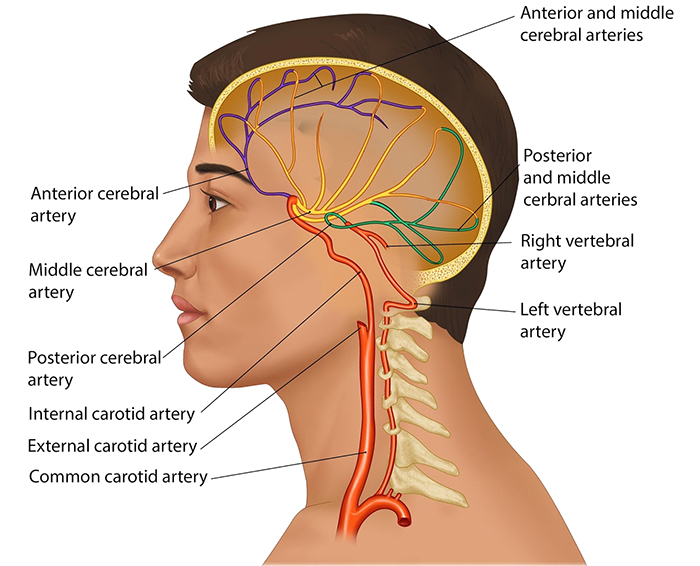Swallowing information for stroke.
Definition:
Swallowing is a complicated sequence of both voluntary and reflex movements, which needs your brain to coordinate many muscles and nerves.
Dysphagia is the medical term for a sensation of difficulty or abnormality of swallowing. It can happen rapidly, or slowly and has many causes
A stroke is the term used when a part of the brain is damaged because of a problem with blood flow. Strokes can happen when:
- An artery going to the brain gets clogged or closes off, and part of the brain goes without blood and therefore oxygen for too long.
- An artery breaks open and starts bleeding into or around the brain.

Globally, stroke is the second most common cause of death, and the third most common cause of disability.
The effects of a stroke depend on a lot of things, including:
- Which part and how much of the brain is affected
- How quickly the stroke is treated.
Sometimes a stroke can damage the parts of the brain that control swallowing. This can make eating, drinking, taking medicine and breathing difficult.
Many stroke survivors experience dysphagia or trouble swallowing at some point after a stroke. Difficulty swallowing is most common immediately after a stroke. However, it can continue and evolve for some time afterwards.
Symptoms you might experience include:
- Drooling or leaking out your mouth.
- Poor tongue control.
- Not being able to chew properly.
- Food pooling in the mouth
- Difficulty initiating a swallow
- Loss of gag reflex
- Weak cough and voice.
- Delayed swallowing reflex
- Food or liquids getting stuck in your throat
- Coughing or choking while swallowing.
- A wet ‘gurgly’ sounding voice.
- Taking longer to finish a meal.
- Loss of weight.
- Recurrent pneumonia.
If you can’t swallow correctly then food and drink may be getting into your airway and lungs. This is called aspiration. If this happens it can lead to infections and pneumonia, which can be very serious. It is important that any changes to your swallowing are identified early, to avoid this happening.
After a stroke, aspiration isn’t always noticeable, due to changes in sensation as well as movement in the upper airway and digestive tract. Some people seem to swallow well, but food or drink may still be getting into their lungs. This is called silent aspiration. Only an instrumental assessment such as a videofluoroscopy (x-ray) or Flexible Endoscopic Evaluation of Swallowing (FEES) with a trained professional can confirm whether you are swallowing safely.
Causes:
Different areas of the brain control swallowing. A Stroke can affect one or multiple areas of the brain that either cause paralysis of the swallowing muscles, poor sensation in your throat, and/ or impaired coordination of the swallowing process.
Diagnosis:
Your neurologist or physician will usually have ordered brain imaging, such as a CT scan or MRI to confirm the diagnosis of a stroke. These scans will also provide important information about the area(s) of your brain that has been affected, and further inform the impact it may have on your swallowing, voice and airway function.
The diagnosis of dysphagia involves a thorough case history, clinical examination of the muscles and nerves required for swallowing, digital nasendoscopy of the upper airway and pharynx, and an instrumental swallowing evaluation such as Flexible Endoscopic Evaluation of Swallowing and/or a Videofluoroscopy Swallowing Study (VFSS).
Additional tests may be required such as a standard barium swallow, video-stroboscopy, high resolution impedance manometry, pH testing and/or salivary pepsin testing. A validated questionnaire, called a patient-related outcome measure, is often completed initially, and repeated later on to measure your progress. E.g.Eat-10 or SWAL-QOL.
Management:
Your Neurologist and/or physicians will have advised the best acute and long-term treatment of the stroke and its underlying cause.
Once you have had a complete swallowing evaluation, the swallowing specialists can recommend ways to improve your ability to eat and drink depending on the specific problems found:
- Specific Treatments:
- If you have a focal muscular weakness or spasticity, this may be able to be treated with a procedure to improve closure or relaxation in your swallowing muscles–e.g. Vocal cord filler injection, Botulinum Toxin to tight swallowing muscles.
- Exercises to improve muscle strength and coordination.
- Swallowing Modifications:
- Strategies to improve swallowing safety. E.g. tucking chin down, turning head to side.
- Safe swallowing strategies such as eating slowly or taking smaller mouthfuls.
Initial recommendations:
- Take your time when eating and drinking
- Avoid distractions such as television and other people
- Use a teaspoon to take smaller mouthfuls
- Eat smaller meals more often if swallowing is tiring.
- Ask your GP or physician today whether you need a swallowing evaluation.
- See your GP urgently if you are coughing and choking after swallowing, have a fever, or a productive cough.
